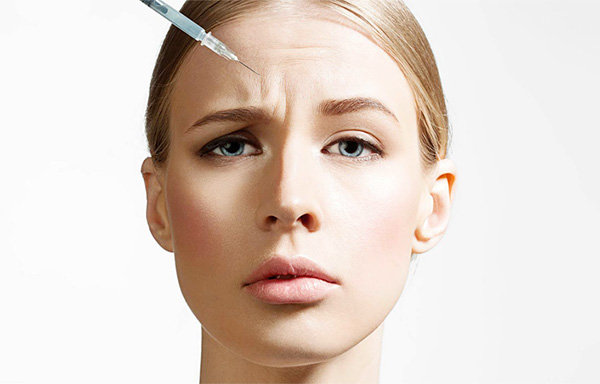
Despite the high safety of botulinum therapy, there are certain contraindications to Botox injections. They are associated both with the direct effect of neurotoxin on the muscles, and with poorly studied effects of its use in certain physiological conditions (for example, during pregnancy).
It is noteworthy that despite the relatively small list of contraindications themselves, a fairly wide range of patients corresponds to them. For this reason, situations when you can not do Botox injections happen quite often. Sometimes the conditions that are contraindications are temporary, and sometimes the patient is forbidden for years to do such injections.
At the same time, not all contraindications to the use of botulinum toxins are equally stringent. Among them are absolute, in which therapy is prohibited in principle. As well as relative contraindications exist, which are more correctly called warnings: if they are, injections are not prohibited, but they must be done with great care (in such cases, the doctor should make a decision on the procedure, evaluating some additional factors).
Next, we will examine how severe these or those contraindications to Botox injections are, and which ones should be considered only as factors in which botulinum therapy should be carried out with great care.
On a note
Almost all the nuances, which will be discussed later, are the same for Botox and other botulinum toxin preparations (Xeomin, Relatox, Dysport, etc.). It is very likely that in the presence of one or another limiting factor in a patient, injections of one drug will cause approximately the same undesirable reactions as injections of another agent.
Contraindications to botulinum therapy
All contraindications to Botox injections can be divided into two groups: absolute, and relative.
The first includes those that are categorically not subject to violation. They were established by various regulatory organizations (initially for the first botulinum toxin preparations they were prescribed by the FDA in the USA) and are indicated, inter alia, in the instructions for use for the drugs themselves.

All absolute contraindications can not be categorically ignored, they are listed in the instructions for the drug.
These include:
- Pregnancy and lactation;
- Allergy to any of the components of the drug;
- Children's age up to 3 years;
- Infectious skin lesions at the sites of the alleged administration of the drug.
In the presence of at least one of these factors, the use of botulinum toxin is strictly prohibited.
Less severe contraindications (relative) and limiting the use of neurotoxins are factors:
- The use of certain antibiotics and antidepressants;
- Oncological diseases;
- Infectious diseases in the acute stage (including acute respiratory viral infections, intestinal infections, sexually transmitted diseases), occurring with severe febrile syndrome;
- Myasthenia gravis;
- Severe facial nerve damage;
- Permanent or frequent exposure to the sun;
- Ocular hernia;
- Active antitoxic therapy, body cleansing procedures;
- Diabetes;
- Hypertension or hypotension;
- Open wounds, sores, scratches and fresh scars on the face;
- Cold;
- Myopia and strabismus;
- Tendency to keloid scarring;
- Recent facial surgery.
In the presence of these contraindications, the cosmetologist comprehensively assesses the situation of a particular person, after which he makes a decision on conducting therapy or on refusing it.

If the patient has certain diseases, the doctor decides to conduct therapy, evaluating all the risks and possible consequences.
On a note
There are also contraindications that can not be attributed unambiguously to a particular group. For example, a history of botulism is often indicated as a definite contraindication to botulinum toxin therapy, however, cases of successful injections with a pronounced result without any serious consequences in patients who have previously experienced botulism are known. This is another confirmation of the fact that a specific patient’s situation should be assessed by a doctor who understands the specifics of the action of botulinum toxin, the causes of certain restrictions and the possible consequences of their violation.
Let's take a closer look at each of the above contraindications and find out why it is not recommended to inject Botox or its taxes in such cases.
Pregnancy and lactation
This contraindication refers to the most stringent (absolute). It was officially established in the United States in 2002 by the FDA; it is also indicated in the instructions for use for all botulinum toxin preparations.
The reason for this ban is the lack of data on how injections of Botox or other similar drugs can affect the course of pregnancy and fetal development. There is no complete information on whether botulinum toxin is capable of causing intramuscular injections to cause disturbances in the development of the fetus or change the functioning of the woman's reproductive system.

Pregnancy is a strict contraindication to the use of Botox, since there is currently no accurate data on the effect of these injections on the development of the fetus.
Theoretically, Botox injections during pregnancy do not represent an unambiguous danger. However, the actual safety of botulinum therapy for pregnant women has not been verified, which means that there is no certainty that the injections will actually be harmless.
Specifically for the use of botulinum toxin, such contraindications are of high importance. The fact is that before carrying out any procedure and before using any pharmaceuticals, the doctor correlates the benefit and significance of such an appointment for the patient, comparing it with a possible health risk.
For example, if a doctor prescribes an antibiotic, he runs a perceived risk that the antibiotic can cause digestive upset, allergies, or other side effects. However, these actions of the drug do not threaten the patient's life, while an infection that the antibiotic can fight can be deadly. Therefore, side effects in this case can be neglected in order to solve a more serious problem.
In the case of Botox injections in cosmetology, the situation is such that even a minimal risk does not allow the doctor to use this remedy for a pregnant woman. The use of botulinum toxin in the fight against wrinkles has no significance for the patient’s health and life, and even the hypothetical risk to the development of the fetus associated with its use is an occasion to refuse injections. Since it is not known today whether botulinum toxin can affect fetal development, pregnancy is a strict contraindication for its administration.
On a note
The same principle is also relevant for many other contraindications to Botox injections: if there is at least a minimal risk of procedures, it is more reasonable to refuse them, at least for a while.
The same is true for breastfeeding: doctors do not know for sure whether mother's botulinum therapy can affect the condition of the infant, and therefore, such injections are not given to nursing mothers.

Due to the lack of data on the effect of Botox on the condition of the newborn, the introduction of botulinum toxin injections to lactating women is strictly prohibited.
At the same time, menstruation and premenstrual syndrome are not a contraindication to Botox injections, although it is generally believed that it is better to wait until they are completed and only then do “beauty injections”.
Children under 2 years old
Here we are talking not about cosmetology, but about therapeutic use of botulinum toxins: they are often used in the treatment of cerebral palsy, strabismus, cervical dystonia and other neurological diseases in children.

Botulinum toxin for the treatment of strabismus in children under 2 years of age is prohibited.
Previously, the age limit for such procedures was set at 12 years. It was believed that at an earlier age, it is dangerous to inject a child with a neurotoxin. However, after numerous studies, the permitted age was reduced to 2 years. Nevertheless, the decision on the use of the drug in a child is made only by a doctor, assessing the condition and possible risks.
On a note
It is clear that Botox is not used at all in cosmetology in children - this is not necessary, because even in adolescents wrinkles still do not develop due to very elastic skin and the absence of long reflex contractions of the facial muscles. The need for injections to eliminate wrinkles usually arises no earlier than 25 years of age, when there are no age restrictions on these procedures. Simply put, when Botox is really needed to eliminate wrinkles, it is already possible to prick it.
A relative contraindication to botulinum toxin injections is also age over 60 years: The result of injections in the elderly is less predictable and there is a risk of asymmetry of the face. Moreover, for such patients, the possibility of using botulinum toxin is evaluated by the doctor individually on the basis of the severity of wrinkles, the features of the facial muscles and other parameters.
A history of botulism as a contraindication to Botox injections
As already noted above, this contraindication is not strict, and there is a specificity here.
It is believed that after the transfer of botulism, the patient may develop immunity to botulinum toxin, due to which the active substance of Botox or other analogous drugs will be neutralized by the immune system, and the procedure will not give a result.
In fact, it is known that botulism almost never leaves immunity due to the very small amount of toxin that affects the body. The amount of neurotoxin in case of poisoning, which can cause an immune response, will almost certainly kill the victim.
Consequently, even after botulism, botulinum toxin injections are likely to be effective. Even if an extremely rare situation arises, and immunity forms, it will only lead to the fact that the injection will not give a result. For the patient’s health, this situation is not dangerous, and therefore consider the history of botulism as a contraindication to botulinum therapy is unreasonable.
Drug allergy
An allergy to the drug is another strict contraindication to its use. If you are allergic to either botulinum toxin itself, or to any auxiliary component, severe complications may develop, up to anaphylactic shock with a fatal outcome. Therefore, at the slightest manifestation of an allergy to Botox (or an analogue), it is impossible to inject the drug.
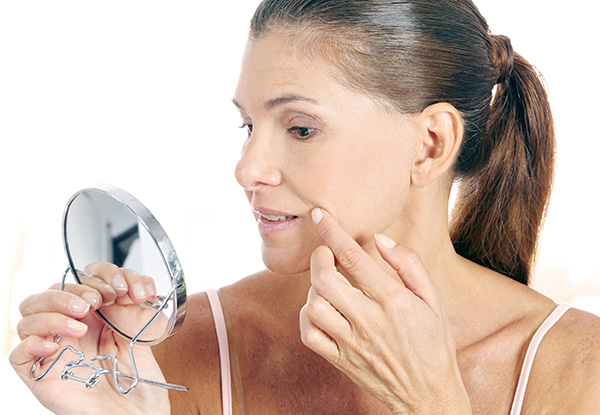
The presence of an allergy to botulinum toxin or another component of the drug is a strict contraindication to botulinum toxin therapy, since the health risks in this case greatly exceed its benefits.
On a note
In the entire history of the use of botulinum toxin in cosmetic practice, 98 cases of death from complications after procedures have been officially registered. The vast majority of them (more than 80 cases) are associated with the development of allergies.
Most often, an allergy occurs to botulinum toxin itself, as the most active antigen.The likelihood of signs of hypersensitivity to auxiliary components - albumin, gelatin, associated proteins - is much less likely, but also exists.
With an allergy to botulinum toxin, any of its preparations are contraindicated. If you are allergic to any of the auxiliary components, it is possible to choose a drug that will not contain an allergen and which, therefore, will not cause a hypersensitivity reaction.
Acne, facial rashes, and skin infections
With various infectious skin lesions at the sites of the alleged drug administration, botulinum toxin injections can lead to increased symptoms and complication of the disease.
In particular, contraindications are:
- Acne with severe hyperemia;
- Herpes on the lips, on the forehead (a rarer form) or near the eyes;
- Barley on the eye;
- Rosacea and rosacea of various etiologies;
- Psoriasis;
- Various dermatitis;
- Numerous papillomas, moles and nevi.
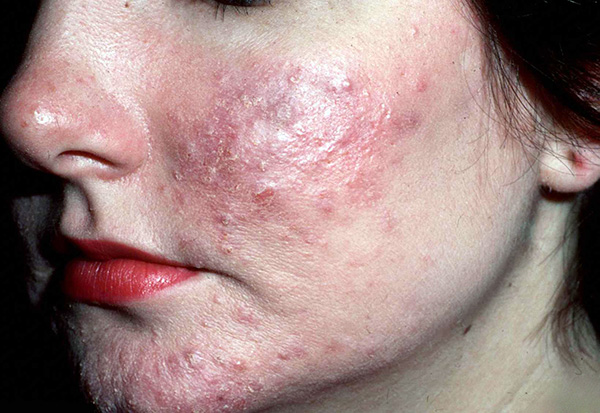
In the presence of a pronounced inflammatory process on the face, Botox injections are not performed.
The severity of certain skin lesions should be evaluated by a doctor immediately before the procedure. By standards, injections are given into the muscles with perfectly healthy skin and no signs of inflammation or infection.
Deviation from these norms is possible in exceptional cases by decision of a doctor. For example, with herpes on the upper lip, the doctor may give injections in the interbrow or muscles on the forehead. And vice versa - with acne on the forehead, injections into the nasolabial folds may be acceptable, but the doctor still has the last word.
Oncology
This contraindication to the use of Botox is also relative, and the doctor makes the decision to administer the injections after examining the patient and studying his medical history. In this case, a lot depends on the stage of the cancer, the location of the tumor and the therapy.
So, during chemotherapy, a severe course of the disease and taking powerful drugs, you can not inject Botox. At the same time, with an illness at an early stage, for the treatment of which an operation is being prepared, or conservative treatment is carried out (for example, with skin cancer not on the face), botulinum therapy may be acceptable.
It is important to soberly assess the need for cosmetic procedures themselves with the development of oncology. If we are talking, for example, about pathology at an early stage, easily amenable to treatment or surgical removal, then botulinum therapy may be permissible. In severe diseases, for which the outcome of treatment is unknown, and the pathology itself significantly affects the patient's condition, the additional burden on the body during botulinum therapy can be completely inappropriate.
Taking certain types of antibiotics and antidepressants
Botox injections are contraindicated when taking antibiotics and antidepressants, among the side effects in which weakening of neuromuscular conduction is described. The use of such drugs has an effect similar to the effect of Botox injections - relaxing facial muscles, reducing the severity of wrinkles.

Some doctors do not recommend botulinum therapy in parallel with taking antibiotics, as there is a possibility of side effects in the form of facial defects.
If botulinum toxin is administered in parallel, two possible reactions are possible:
- Excessive relaxation of the muscles and the formation of various facial defects, a “wax” face, asymmetry of muscle contraction - in case Botox injection complements the effect of the drug;
- Or vice versa, a decrease in the result from the use of Botox is possible due to the fact that the cosmetologist, evaluating muscle contraction and the severity of wrinkles, will not see a real picture, but a picture weakened by the action of the antibiotic.Therefore, if the patient really needs to enter, say, 20 units of Botox, it may turn out that due to muscle relaxation caused by the medicine, the cosmetologist will decide to introduce, for example, 12 units. When the antibiotic is stopped and its effect on the muscles is completed, the full reduction of muscles will be restored and it turns out that the dosage of Botox was insufficient, and wrinkles were largely preserved.
This is true for antibiotics of the groups of aminoglycosides, macrolides, tetracyclines and lincosamides, some antidepressants and a certain set of other drugs. The list of such drugs includes more than 300 items (including blood anticoagulants), and their effect on the result of Botox injections can be different. Therefore, agreeing with the doctor on the procedure, it is necessary to inform him which medicines were taken shortly before the visit or continue to be taken, and the specialist, taking into account this information, will decide on the possibility of injections.
Myasthenia gravis
Myasthenia gravis (muscle weakness) at certain stages can be a clear contraindication to botulinum toxin therapy due to the risk of severe muscle paralysis. With myasthenia gravis, neuromuscular conduction is initially impaired, due to which the muscles are weakened by themselves. If Botox also reinforces this condition, then complete paralysis is possible with serious complications - ptosis, drooping cheeks, “wax face” effect and other unpleasant consequences.
At the same time, upon completion of treatment for myasthenia gravis or with persistent remission, the cosmetologist may decide to administer Botox in small amounts to the most problematic places. In any case, he must know that the patient has myasthenia gravis.
Ocular hernia
Despite the relative safety of this pathology, it is contraindicated to put Botox due to increased symptoms and an increase in the "bags" themselves. This contraindication applies only to injections into the corners of the eyes and around them, that is, into those muscles whose tone provides a “tightening” of the hernia itself and does not allow it to increase in size.
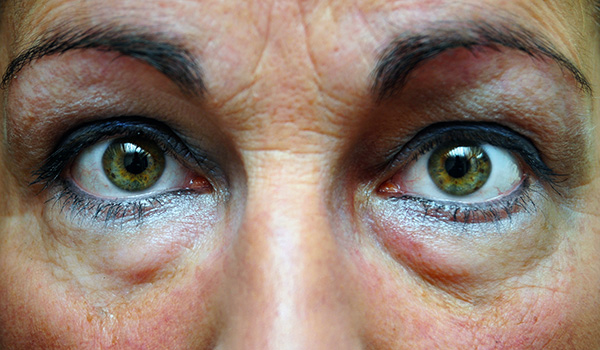
Injections in the area around the eyes are not recommended in the presence of ocular hernia.
If this contraindication is neglected, then the "bag" under the eye can significantly increase after injections.
At the same time, injections into other muscles of the face with ocular hernia are not contraindicated. With this defect, you can get rid of nasolabial, glabellar and frontal wrinkles.
Relative contraindications
There are also restrictions on the introduction of botulinum toxin in the following cases:
- Severe facial nerve damage, in which Botox cannot be injected at certain points because of the risk of the patient worsening. However, with the correct assessment of the lesion and an adequate choice of the points of drug administration, procedures can be performed;
- Patient taking special anti-toxic drugs, passing intensive programs to “cleanse” the body of toxins and toxins. In this case, the drugs taken can neutralize, including botulinum toxin;
- SARS, a cold with a runny nose in the acute phase with a pronounced febrile syndrome. Botox injections themselves can cause a flu-like syndrome, and with SARS it will increase even more. Moreover, it is unreasonable to carry out cosmetic procedures at a high body temperature and clearly poor health;
- Diabetes mellitus - there is no exact data on how Botox injections can affect blood sugar, and therefore, in such cases, increased caution should be exercised;

In diabetes mellitus, Botox should be used with caution, since the effect of botulinum toxin on blood sugar levels has not been fully studied.
- Chronic hypertension or hypotension in the patient - presumably, pressure surges can affect the diffusion of neurotoxin in the tissues and its effect on nerve cells, which can make the result of injections in people with this contraindication unpredictable;
- The tendency of the patient to keloid scarring. In this case, it is not botulinum toxin itself that is dangerous, but injections and microdamages of the skin, on the site of which small, but noticeable scars may form after injection;
- Myopia, hyperopia or strabismus - require high professionalism from a cosmetologist. The fact is that the inactivation of the eye muscle by Botox can greatly affect the course and severity of these pathologies;
- Wounds, ulcers, large scratches, recent surgical interventions on the face - all of them can heal with an unnatural and unpredictable scar formation if botulinum toxin acts on one or more adjacent muscles. At the same time, with well-administered injections, on the contrary, it is possible to achieve better healing of the wound and less visibility of the scar. Therefore, in some cases, on the contrary, wounds on the face are an indication for botulinum therapy, if the doctor understands how and where to inject;
- The lifestyle or work of the patient associated with constant exposure to the sun. With prolonged and intense sun exposure, the effect of Botox can be enhanced, and its effect can be extended to those muscles in which it is undesirable (this will lead to various aesthetic side effects).
It is also not recommended to inject Botox with parallel facial massage - increased blood circulation can provoke increased diffusion of the toxin in the tissue and the excessive effect of the procedures, including with various complications.
After rhinoplasty, Botox is placed no earlier than a month later, when the regeneration of nasal cartilage tissue is completed.
In general, various diseases with pronounced symptoms are warnings for Botox injections. For example, botulinum therapy with multiple sclerosis, rheumatoid arthritis, digestive disorders, and infectious diseases should be carried out with great caution. Even with chronic diseases, they need to be reported to the doctor before the procedure, and he will already decide whether to give injections.
Feedback
“The first two times I did Botox and Dysport, the second was cheaper. The third time I decided to save a little more and put relatox. The doctor said that relatox alone is cheaper, plus it is more effective and less needed, as a result, the price should be 30-40% cheaper than Botox. So, the drug did not take at all. Even some weakening of wrinkles did not occur, although they were completely smoothed out from Botox and dysport. Plus, the face was wildly scratched from the injections - before this was not. I knew that when you are sick and drink antibiotics, you can’t inject, and therefore I specially waited a week after a sore throat. But it didn’t work ... "
Lyudmila, Cheboksary
What can replace Botox if it is contraindicated?
With most contraindications to the use of Botox, it is automatically assumed that other botulinum toxin preparations (Dysport, Xeomin, Relatox, Neuronox, etc.), as well as the so-called mesobotox, that is, the introduction of botulinum toxin not into the muscle, but into the skin, are contraindicated in this case.
On a note
The so-called "nanobotox" has no relation to botulinum therapy, since it is a special cream for application to the skin. Accordingly, contraindications to its administration are completely different than to Botox injections.
If Botox is contraindicated for a particular patient, in some cases some other procedures may be prescribed, which to one degree or another will provide the effect of eliminating wrinkles. For example:
- Reinforcing the skin and muscles with gold threads - a procedure aimed at eliminating dynamic wrinkles, but not allowing to eliminate the smallest of them;
- Biorevitalization, with which you can eliminate wrinkles caused by loss of skin moisture and hyaluronic acid. And although this procedure does not give a completely similar result to botulinum therapy, the effect of it in the fight against wrinkles is generally similar;
- Injections of individual peptides that have a similar effect to Botox;
- Contour plastic injection of hyaluronic acid (synthetic gels).
Not always, these procedures allow you to achieve the same effect that Botox provides, but sometimes it may well replace it. Nevertheless, it should be remembered that such manipulations also have their own contraindications, which also need to be considered before starting facial plastic surgery.
Useful video about the main contraindications to the use of Botox
The expert says: when and in which cases you can not do Botox injections

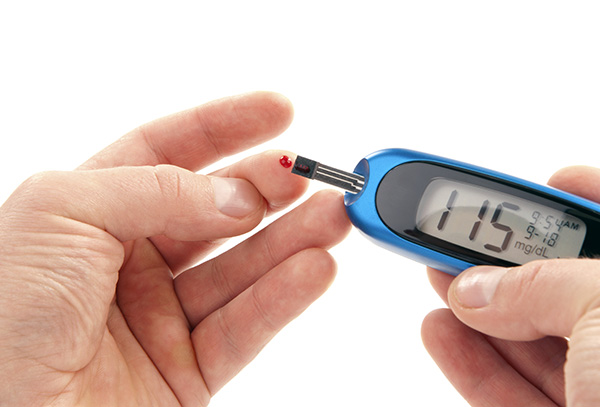
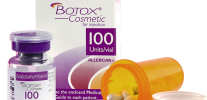
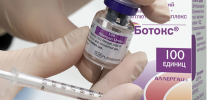
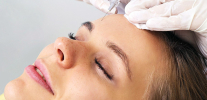
Many cosmetologists say that botulinum toxin treats cancer, but how is it possible - I can’t understand if it is written everywhere that it is contraindicated.
Hello. Is it possible to alternate? Sometimes botox, sometimes dorsport?
Hello! Is it possible to use hardware cosmetology for a person: facial ultrasound (5 million vibrations / sec), RF lifting, skin cleansing - Clarisonic (300 vibrations / sec) after botulinum toxin injections? Can these procedures reduce the effectiveness of botulinum toxin?
Hello. After the injection of botulinum toxin, any electrical procedures and procedures that cause increased blood and lymph circulation, muscle stimulation are contraindicated. These include RF lifting and ultrasound. NOT!